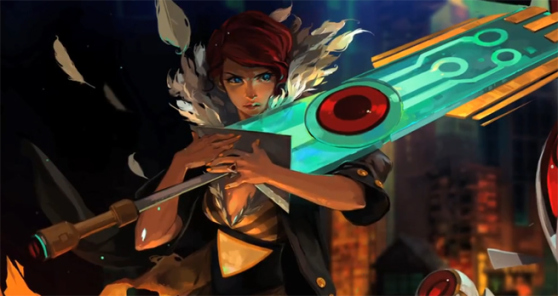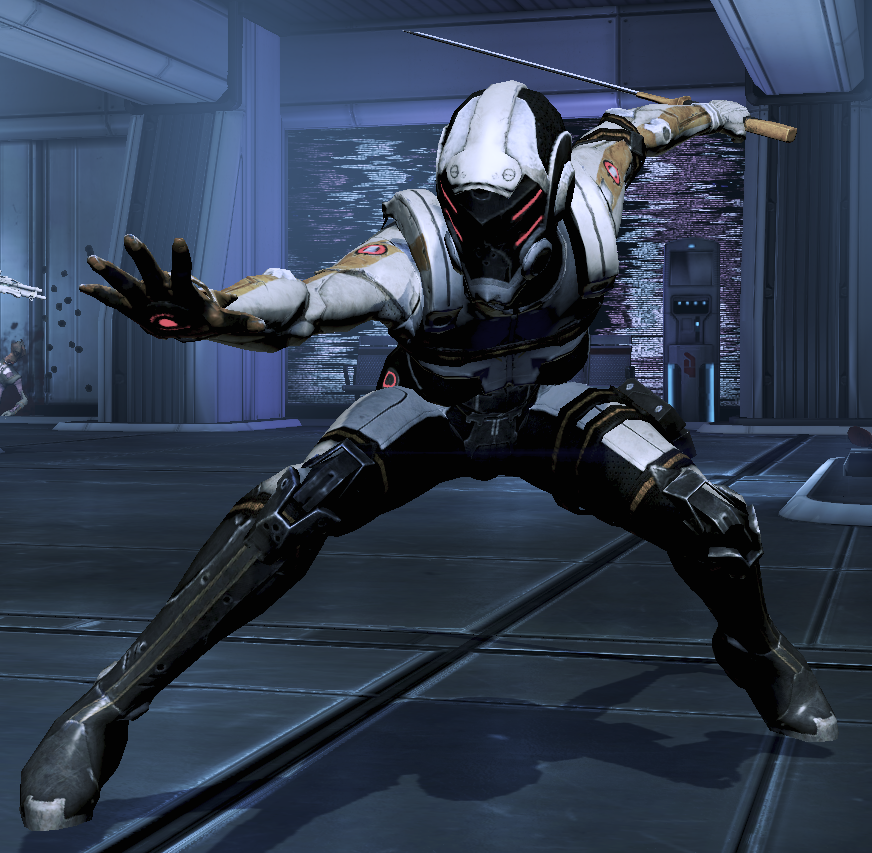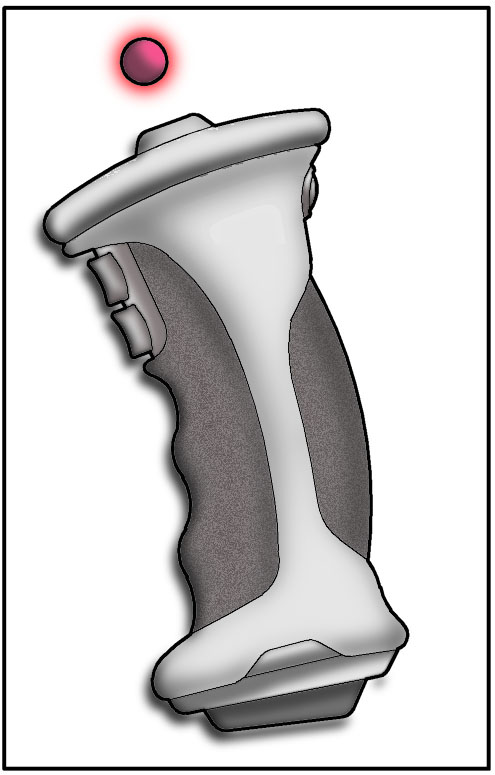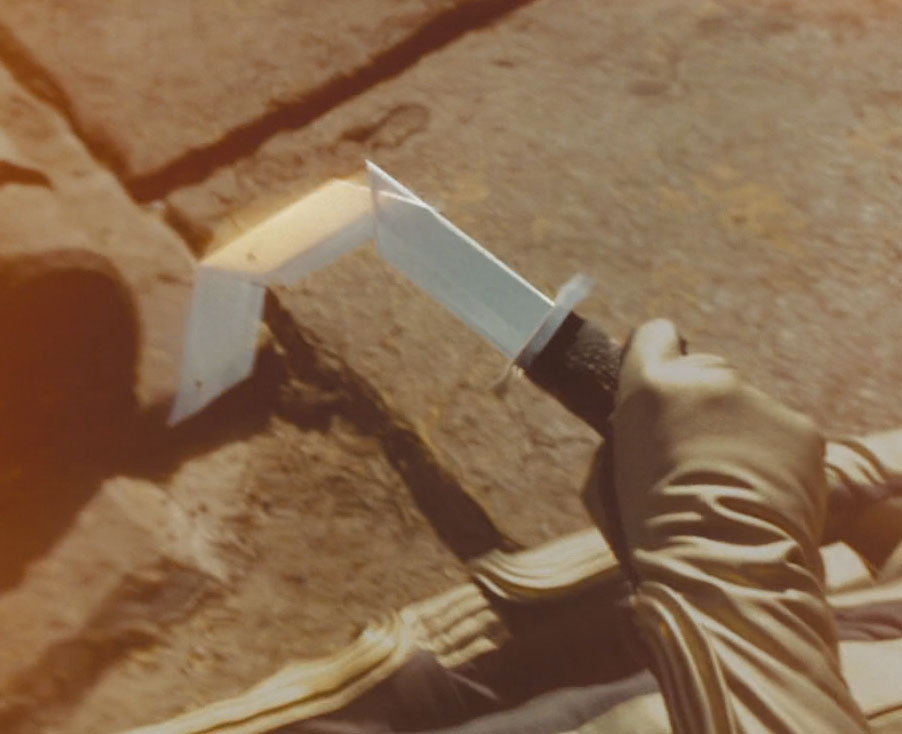So I've been away from this blog for awhile, although not for any special reason. Apparently some months I come home from the gym and want to write thousands of words about Neuromancer or Weird Fantasy New Mexico, and other times I just want to spend my free evenings reading a bunch of books about people shooting each other in the future. And even one book about people not shooting each other in the future, which seems like a pretty radical notion. I even took a (needed) break from the Shadowrun campaign.
And then, just as I was ready to return to the world my computer broke. Woop woop.
So now my laptop is working again - sort of - the time has come to write something! There's lots to do - Alienation follow-up posts, Aviationpunk, a whole bunch of stuff about Shadowrun and Dungeons and Dragons and cyberpunk warfare... or I could just write a post about futuristic swords.
Because futuristic swords! Because, to quote Snow Crash, swords need no demonstration.
This post is going to cover the setting assumptions that might allow a character in a science fiction game to actually carry a sword and not look like a sociopath or an idiot or a sociopathic idiot, and then follow up with a survey of different futuristic swords from monoblades to cheap plastic terror weapons and everything in between!
 |
| Dishonored's beautiful, industrial sword |
Two things I love - first: pop culture that takes a genuinely ludicrous concept and then treats it completely seriously (like "futuristic swords" or the movie Point Break). Second: the aesthetics of futuristic swords. Video games like Dishonoured and Knights of the Old Republic that take a medieval weapon and update it for the industrial age. Those early sequences in KOTOR where the character is fighting his way through decaying city blocks, crossing blades with gangsters, magnifying his combat abilities with high-tech targeting interfaces and implants...
Of course, characters in KOTOR wear decent armour and carry personal energy shields that allow them to reach close combat ranges. That isn't always available to characters bringing long knives to automatic smart-gunfights.
Just real enough reasons to carry a sword
So: what will determine the future design of the sword? Practicality! Yep...
I'm writing a post about futuristic swords because I really like swords. I like the way they look and I like the narrative load associated with the basic, battle scarred long sword. I'm aware that they basically make no practical sense at all in a science fiction game.
Not because they're melee weapons. Non-lethal close combat weapons aren't going out of fashion any time soon. Short, practical blades possess even more potential longevity, especially in a Traveller style setting - but you can't cut meat or rope or bamboo with a sword. A sword is a pure combat weapon, designed to kill trained warriors in close combat. It has no other use outside the realm of symbols and prestige.
These days, it doesn't even work that well in close combat. Pistols can usually outdraw a sword and become exponentially more likely to hit the closer the target gets - if, say, their weapon requires them to come running towards the shooter. Luckily for the swordsman, most turn based combat rules systems don't reflect this very well... (that said, try attacking someone with a sword in Infinity...).
To make things worse, traditional swords are big. You can't hide them easily. Even more so than a rifle, swords look like trouble. People don't carry swords for "self defence".
Don't think about it too hard!
However! I'm not trying to create a realistic piece of futurologist speculation. For cyberpunk worlds i'm a big believer in the art of the "just real enough to make sense in a game" setting explanation. Here are some "just real enough" reasons to carry a long blade in the world of Cyberpunk or Traveller:
If you just like futuristic swords and don't care about legitimising them, skip to Betamax Blades below.
It takes all sorts to run a 3d printer: who said the people making the swords had to be practical, rational people? I'm talking about the fans.
3d printing and rapid prototyping make it easier than ever to design and create ludicrous close combat weapons easily, at home. Why? Well - there are a lot of SCA types, anime cosplayers and Star Trek fans out there who might want to create a Bat'Leth. With cheap ceramics (see below), a Bat'Leth might even be a (somewhat...) practical weapon.
Fans are responsible for some of the most impractical terror weapons out there. A Warhammer 40,000 enthusiast designs a chainsword and puts it on the undernet, and two weeks later gang-soldiers in Lagos are sawing each other up en masse...
Or maybe the long prophesied Wu-Tang revival has finally come to pass, and the fans have printed a million swords to hail their return (with horrible consequences for everyone).
It takes all sorts to store feedstock for a 3d printer: fans aren't the only people with a taste for lunatic close combat weapons. Gangsters and nomads have their own sharp dreams (even if they happen to prefer cyberweapons). A 3d printer with the safety turned off can churn out plastic or metal weapons of low quality and lower cost. Laser-cut blades work well in a pinch, or against a line of riot police.
A common tactic among urban guerrilla forces is to keep their weapons in potential - i.e. to keep reserves of necessary metal feedstock ready for the day of the uprising. Often, they'll have to resort to creating weapons using common shop printers, which might well have both DRM systems and police software designed to stop the construction of more elaborate weapons. Sharp blades - or just the handles for such - are more easily passed through such defences.
Don't fire that gun! You'll decompress the entire habitat!
It isn't easy being a murderous killer on a space station for all sorts of reasons; the risk of an over-penetrating bullet is just one. In Schismatrix social prohibitions against ranged weapons run so deep that pirate crews practically have to be deprogrammed to fire their ship's cannon.
Or perhaps, in older stations and decaying lunar cities, a culture of duelling and bladed weaponry has grown up. I've seen this idea used in more than one RPG setting. And Dark Heresy remixes it a little: this time the hives of Landunder are under water, and the bladed weapons especially imaginative.
A variation on this theme might be the "Deus Ex" option. 2050s Hong Kong is full of acoustic gunfire detectors, so the Triads have had to fall back on swords (because apparently, while they can build temple fortresses full of hackers, they can't get suppressors)! This might be the iconic "just real enough" option.
The Sword of Honour:
 |
| Transistor's sword is probably a little big... |
Before you sneer, bear in mind that it's a bit of an enduring mystery among military historians as to why the Gothic tribes favoured sword and spear wielding heavy cavalry over the horse archers that repeatedly bested them. Roman and Persian cataphracts were as likely to use a bow as a kontos cavalry pike, while Arab and Indian aristocrats hardly disdained the weapon. The Samurai's primary battlefield weapon remained the bow well into the age of gunpowder. European aristocrats fought up close and personal for cultural reasons, not out of hard-nosed military practicality.
And frankly, the feudal system was a mafia protection racket with pretty sigils painted over the cracks. If it works for a knight, it can work for a gang culture. In a particular city or arcology bravos might fight complex duels to settle scores and gain prestige, only bringing out the big guns to deal with people who violate the deeply held rules of honour. M John Harrison's Viriconium Nights has inspired all sorts of weird fantasy fans; cyberpunk GMs should feel free to nick the tales of cynical mordant swordsmen for themselves!
 |
| Mass Effect's Phantoms have a neat future gladiator vibe |
The sporting life: talk of honour brings me to Renommierschmiss duelling scars, and the question of sport.
In an age of virtual reality, perhaps there's a fad for games with real, physical consequences. Perhaps some version of German academic duelling has returned to corporate academies, and executives proudly wear Heidelberg duelling scars (like in Jon Courtenay Grimwood's alternate future Arabesk trilogy). Now that cyberware can ameliorate those "real" consequences, wealthy kids might duel with edged weapons.
Or they might watch gladiatorial fights. Fighters wearing power-frames or covered in cyberware, fighting to the first injury or beyond, ripperdocs waiting to patch up the increasingly inhuman survivors...
I imagine gladiatorial combat might become as stylised as it was in Roman times, with different styles derived from different street fighting styles and martial arts. The weapons created for these contests would become increasingly specialised and increasingly strange.
Political chaos:
 As a suburban nerd I've only rarely seen melee weapons actually used in anger. In fact, there was just the one time: when I was working in Egypt back in 2011 and had the dubious honour of seeing a revolutionary militia beat the crap out of alleged thief with long palm sticks. Back then the local news was full of pictures of revolutionary "terrorists" captured, their alleged weapons - all intimidating long blades - proudly displayed for the cameras. At times during the Cairo Spring gangs of "thugs" fought attacked protesters and ordinary citizens with improvised melee weapons, hoping to create an atmosphere of terror and chaos that might legitimise the return of government forces to the street. Neither side could afford to use guns first - it would have been political, or literal, suicide. It was a war of sticks and stones, riot shields and firebombs... and who can forget the camel charges?
As a suburban nerd I've only rarely seen melee weapons actually used in anger. In fact, there was just the one time: when I was working in Egypt back in 2011 and had the dubious honour of seeing a revolutionary militia beat the crap out of alleged thief with long palm sticks. Back then the local news was full of pictures of revolutionary "terrorists" captured, their alleged weapons - all intimidating long blades - proudly displayed for the cameras. At times during the Cairo Spring gangs of "thugs" fought attacked protesters and ordinary citizens with improvised melee weapons, hoping to create an atmosphere of terror and chaos that might legitimise the return of government forces to the street. Neither side could afford to use guns first - it would have been political, or literal, suicide. It was a war of sticks and stones, riot shields and firebombs... and who can forget the camel charges?Using deniable "third forces" to spread terror and disorder is an old political tactic given new life by the atomisation of the nation state in cyberpunk settings. Third force thugs also happen to be a great and unusual opponent for 'runners to face, and they really deserve an entire post to themselves. I'll write that, at some point. For now, i'm just going to talk about the sub-genre of intimidating terror blades spawned in third world Secret Service print-shops, in a section below.
Opposing them could be any number of armed political zealots, idealists and street fighters. Again, this post is focused on swords so i'll stick to a specific piece of inspiration: the Singapore sections of Bruce Sterling's Islands in the Net, in which a social movement devoted to egalitarian politics and martial arts seizes control of most of the city using ceramic blades. A bloody melee battle ensues in the tight tower blocks, where their armour slicing blades do effective work.
Betamax Blades
My brief (obsessive) survey of books and RPG material has uncovered a dozen different options for sharpening a sword's edge, from "dikote" to acid-edged fractal blades.
Some people would suggest I choose the most likely to succeed and concentrate on that one, but that isn't very cyberpunk. Since my setting is clearly going to be set in the middle of some kind of unprecedented sword revival, it stands to reason that different designers and companies will be trying everything. Maybe in three years the market will have settled on something. By that time the PCs will probably be dead (or too old and mature to care about swords), so it doesn't matter.
There are several market impulses driving technological advances in bladed weaponry - naturally, most of them come from the commercial and industrial sectors.
- Fads in cookery
- A need for more complex and precise cutting tools
- A boom in the material sciences brought about by the trifecta of resource deprivation, 3d printing and orbital mining
- The increasing prevalence and effectiveness of stab proof vests, spurring innovation among "tactical" knife developers
All of these trends influence the construction of a modern sword.
We need to talk about monoblades: the old classic!
High-tensile Monofilament-wire has a pedigree in science fiction going back to Dune and Stand on Zanzibar, in which it appears as a terror weapon. We'll come back to that in a second. Larry Niven's Known Space series features an early monoSword - the "Variable sword". Heroic engineers use it to build a space elevator in Arthur C Clarke's Fountains of Paradise, a book which also acknowledges the dangers inherent in the material.
The inspiration for Cyberpunk 2020's monoswords is most likely the assassin's implant weapon in William Gibson's short story Johnny Mnemonic - a strand of monofilament wire implanted in his thumb, attached to a single molecule diamond at each end. When removed, the assassin could use the end of his thumb as a weight, allowing him to use the wire strand as a garrote or cutting instrument.
That isn't a sword, however.
 |
| The Variable Sword (via Star Frontiers link) |
Of course, "inertia fields" raise a problem of scientific plausibility in a cyberpunk game. The idea of a "wire sword" remains interesting - perhaps it could created by looping the wire, or some kind of electric current? If the weapon broke the wire would swing free, probably taking the user's eyes out. Serves them right, really.
Here's the thing about monofilament weapons. They are evil. I don't mean that as any kind of complement regarding their killing power. They are evil in an "ought to be banned by the Geneva Conventions" sorta way.
Have you ever heard the story of what happens to someone who sits on broken glass? How transparent bits can't be detected by surgeons and might sit there, beneath the pain receptors, causing undetected damage or else waiting to be pushed up to the surface years after the injury? Do you think children playing in an abandoned battle zone are going to see strands of broken monowire or shattered monoblades before losing fingers? In Stand on Zanzibar terrorists hang strands of the stuff across streets to injure passing civilians.
(As a side note, various Eldar weapons in Warhammer 40,000 apparently shoot this stuff en masse. Their artillery drops great bundles of it across the landscape. As if you needed another reason to purge the xenos.)
A better - and far more common - option would be to create a monoedge. You might achieve this by applying monowire to the edge of the blade or else sharpening the blade to such an extent that you achieve similar results. People tend to envisage this kind of sword as a sort of ultra-thin nearly transparent blade that presumably makes a pleasing swoooooosh as it literally cuts through the air. Cyberpunk 2020 assumes they are quite likely to break on a parry, and so do I. No doubt a broken monoedge blade is just as dangerous as as abandoned, forgotten monowire laying across the landscape.
Still, the technologies used to achieve the incredibly sharp edges on mono-edged weapons can be applied to all sorts of different material technologies. We'll come back to that later.
Fractal blades: imagine a coastline. From high orbit it might look a hundred miles long. Then you zoom in, and see all the little inlets and bays, and realise the coast is a good deal longer. Fractal blades follow this principle, using modern materials technology. The serrations on the sword might be almost invisible to the naked eye, but they add up to create an edge almost twice as long as the blade itself.
Vibro-Swords: After monoblades, vibroblades are the most common advanced melee weapon in science fiction games. They also have by far the stupidest name.
As the name suggests, vibro-blades vibrate at a high frequency, perhaps because of an ultra-sonic generator in the hilt. While Star Wars popularised the idea, TV Tropes informs me that they were present in a Robert Heinlein novel back in the 1940s. This supposedly allows them to cut through virtually anything. There doesn't seem any reason why a monofilament or fractal blade couldn't also be a vibro-blade. Indeed, Cyberpunk 2020's sole addition to the vaunted vibro-blade canon is the Kendachi "Power Sword", pitched as a monoblade taken to an extreme.
Almost every science fiction RPG has some version of this weapon, each taking a slightly different approach. Most simply increase the damage of an ordinary sword somewhat. I rather like Eclipse Phase's alternative take - while the lightweight vibroblade is less effective than some of the monoblades and diamond axes on offer, it is rather better at extended sawing. If this post was about melee weapons in general, i'd probably go on at length about improvised vibro-weapons.
I can't get over how awful the name is.
For awhile, I thought about just shortening it. V-Blades? Then I discovered alternatives: Jovian Chronicles calls them "Hummer Blades" which has a little promise. CP2020's "power sword" is too generic and too similar to Warhammer 40,000's iconic electrified armour smasher. An ancient relic in Knights of the Old Republic 2 distinguished itself from more modern equipment by calling itself a "tremor sword". That I could live with!
That said, I feel the need to solicit more ideas from the audience.
Vibroblades seem like an effective military weapon, if the power issues can be dealt with. I imagine early cyberpunk era vibroswords as very lightweight - enough that their unpowered Cyberpunk 2020 damage might be as little as 1d6 and their parrying capability negligible. A military vibro-shortsword might be designed as much as a cutting tool as a weapon, designed for tearing through walls and doors and rubble. A vibrating point might also be the solution to a problem with retractable blades - see below.
For me, the big advantage of a vibrating weapon is as a force multiplier - allowing a much lighter blade to do damage equivalent to an older weapon of equivalent size.
Chainswords: if it's simply a blade in motion you want, there are simpler to achieve it. You could build a chainsword.
 |
| Chaos Marines in power armour don't worry about ripping their own face off! |
No matter. Someone, somewhere will build one. Cosplayers already have. Eventually someone will build one designed to work, and print it. Then s/he will put the designs on the internet. Someone else will print one, and use it on a fellow gangster. There will be a red midst. Chunks of human will fall everywhere.
The user of the chainsword will then sit down. He will look at the splatter and past the splatter, into an existential void. He will reconsider his life, and everything that brought him to this pass. He will feel PTSD fall upon his mind like a shroud. He will put aside his material possessions and travel to a nearby monastery, to live out the rest of his haunted days.
Meanwhile, one of his teenage followers will pick up the sword and breathe "woah. That was soooo cool." And buy some monofilament teeth.
(In my opinion, chainblades should do significant damage to armour, tearing it apart. In Cyberpunk 2020 terms I ruled them to be armour piercing vs soft armour. Moreover, they would cause heavy SP damage to that armour on a successful strike, in addition to any other attack. Along with some horrible fumble consequences, that would serve to differentiate them from AP monoblades, controllable vibroblades and high damage diamond swords.)
Retractable Blades: for someone who spends quite a lot of time writing about cyberpunk fiction I'm surprisingly wedded to the utopian idealism of Star Trek. For that reason I wasn't an enormous fan of the new films, as fun as they were - I object to the way the new crew solved every problem with a gun battle. And there seemed something faintly racist about the way Sulu suddenly pulled out a sword...
Which apparently didn't stop me from enjoying that sequence.
Retractable blades have a fine tradition in video games - Dishonored has a particularly nice one, pictured near the top of this post. Cyberpunk characters often carry implanted weapons which punch or telescope out of metal sheaths with brutal abandon.
There are practical limits on the weight and size of a retractable or telescoping blade. You'd also need a pretty damn reliable locking mechanism to keep it from snapping back on impact. Some kind of electromagnetic thing?
This is where vibro-technology comes in. A vibro-retracto-sword wouldn't necessarily need the same degree of force to cause bone-slicing injuries, allowing for a lighter blade. Lighter blades mean a simpler, more reliable mechanism. It would raise the possibility of a secret agent pulling out a concealed sword from a simple... thermos flash? Coke can? Something more stylish, I hope! Far better than a stupid sword cane, at any rate.
I could of course be entirely wrong about this. Please tell me in the comments if I am!
There are other options for creating a retractable sword. Memory plastics and metals, and:
And beyond that, political terror weapons! Screaming swords! Hobbyist blades! And more!



Gotta say I might spend some time consuming your blog. I say I like your approach, Sir (:
ReplyDeleteI was gonna chime in with a concept of retractable monoblade executed as an assembly of metallic particles suspended within a magnetic field, but that's apparently what you're writing about next. Such a device appeared, if I recall correctly, in the first Deus Ex installment. Anyway, that's probably a couple generations too high-a-tec for CP2020 [which I tend to obsess over, hence the mention ;p], but for, say, SW it's a viable, if possibly prohibitively priced alternative in HTH market [that would also work to explain Pre Vizsla's pitch black, single-edged "lightsaber" allegedly liberated generations ago that happens to rub me the wrong way the way it's presented ;p]